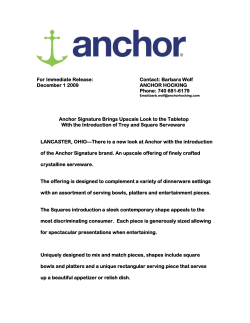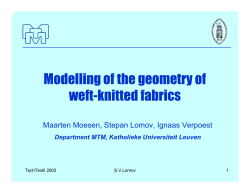
How to anchors in accordance with supply BS 8539:2012
Ensuring best fixings practice www.the-cfa.co.uk How to supply anchors in accordance with BS 8539:2012 Code of practice for the selection and installation of post-installed anchors in concrete and masonry. A guide for distributors of fixings. 1 Introduction BS 8539 is arguably the most significant development in the use of construction fixings since the advent of European Technical Approvals (ETA)1 in 1997. Its introduction was prompted by a series of failures involving fixings, some resulting in injury and death. The role of the distributor in such failures is not a dominant one but may be significant if, for instance, the distributor gives advice regarding the suitability of a fixing which turns out to be inappropriate or an alternative anchor is supplied to that specified and the full selection process has not been carried out on the proposed alternative. The BS sets out all stakeholders’ roles and responsibilities including those of the distributor which are the least onerous of all involved. These responsibilities are in addition to those required by legislation, such as the Construction Products Regulation, etc., and those recommended by other standards. This “How to” guide summarises the responsibilities of those who supply construction fixings to any project where their use can be regarded as safety critical. In addition to being familiar with their own roles and responsibilities distributors are advised to be aware of those of the other stakeholders as they may be the first point of contact that some have with the process so distributors are in an ideal position to make other stakeholders aware of BS 8539. The other “How to” Guides in this series2 may be useful in this respect. 1.2 Terminology Terminology used in the code is based largely on that used in ETA, in ETAGs (the Guidelines used to award ETA) and CEN Technical Specifications3 for anchors (fixings). This has resulted in the adoption of some terms and notation not previously used in the industry especially for loads now referred to as either a type of action (the load to be carried by the anchor) or a type of resistance (the capability of the anchor to support the action). This issue is important for distributors in that they need to be able to communicate effectively and knowledgeably with all other stakeholders including specifiers and testers who will all, at some stage, want to discuss loads. The code even differentiates between the Designer - the person with overall responsibility for the structure in which an anchor is located, and the Specifier - the person responsible for selecting the anchor. For a detailed explanation of the differences between the new and old terminology see4. 2 Responsibilities (BS 8539 Clause 4.1) Anchor manufacturers and their agents i.e. distributors, are required to provide all information for the specifier to select the correct anchor, i.e. technical catalogues and software, and for the installer to install it correctly i.e. installation instructions. The supplier is also required to supply the anchor as specified unless the change management procedure referred to below has been followed. CFA “How to” supply anchors in accordance with BS 8539. (Issue 2. December 2013) 1 of 2 Ensuring best fixings practice www.the-cfa.co.uk They should take the opportunity to ensure that all associated setting equipment is offered to the contractor such as drill bits, hole cleaning equipment, setting tools, torque wrench and sockets etc., in order that the installer can install anchors correctly. Distributors are also in an ideal position to provide training in the correct installation of anchors, or at least to facilitate this being provided by the manufacturer or specialist training agency, in order that their customers can fulfil their obligation under the code to use only competent installers. 3 Distributors’ role in selecting anchors. BS 8539 sets out the process of selecting an anchor through selection of the appropriate type before going on to determine the size needed to carry the required loads. While many distributors will have enough experience to advise specifiers on the most appropriate type of fixing, determining the size - in the case of safety critical applications using anchors with ETA - is now such a complicated process that it can only safely be done using software. Unless Distributors have staff specifically qualified to do this they are best advised to gather the necessary design information and pass this to their supplying manufacturer who will then come up with a recommendation. To assist with these activities the CFA has designed a series of forms available from the CFA website in a special section “CFA 8539 Forms” including Form 01 – Design information and Form 02b – Anchor recommendation. They are part of the “8539 Toolkit”, also with its own section on the website. The BS, and these forms, make it clear that when suppliers of fixings make recommendations they are not taking on the responsibilities of the specifier. 4 Changing specifications. (BS 8539 Clause 10) Distributors are frequently asked to advise on alternatives to specified anchors. While it is entirely reasonable that distributors should use their knowledge and experience to put forward suitable alternative anchors to those originally specified the code makes it clear that any alternative should be subjected to the same rigorous selection process as if it were the first anchor to be considered. It is not enough to compare headline catalogue values or to carry out proof tests on site. Neither of these approaches can be guaranteed to take into account the various factors influencing the way performance changes as edge and spacing distances change. Distributors should therefore enlist the technical support service of the manufacturer of the anchor they propose as an alternative who should be able to provide all necessary support to the specifier by way of technical data or software to enable the alternative to be selected with the same confidence as the original. Again the forms listed above can help with this process. 1 For more information on ETAs see CFA Guidance Note: ETAs and design methods for anchors used in See How to select anchors (for specifiers and designers), How to install anchors, (for contractors and installers) and How to test anchors – for testers. CFA website at www.the-cfa.co.uk . 3 Design methods for anchors with ETA may be contained in CEN Technical Specifications in the series CEN TS 1992-4 Parts 1 – 5. (Otherwise they are as the relevant ETAG.) 4 CFA Guidance Note: Anchor terminology and notation 2 CFA “How to” supply anchors in accordance with BS 8539. (Issue 2. December 2013) 2 of 2
© Copyright 2025





















